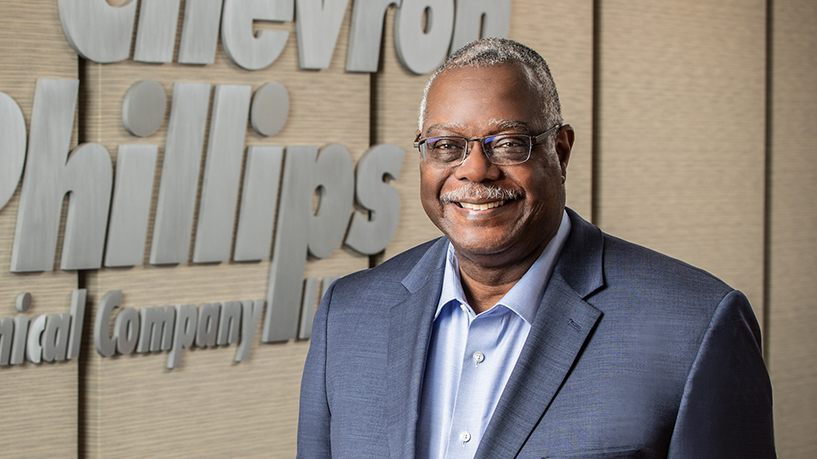Art of Leading
To Bring People Along, You Have To Make The Complex Things Simple
April 6, 2023
Bruce Chinn, Chief Executive Officer of Chevron Phillips Chemical, shares key leadership insights in this “Art of Leading” interview.
Q. What is your approach to leadership?
A. Based on an assessment early in my career, I was called an “amiable driver.” No matter what kind of situation or challenge I’m facing, I always just try to be who I am. I always try to be as transparent as I can about the reasons behind a decision. And I’ve learned to listen more than I talk, because you learn more that way.
So, when I have monthly check-ins with my team, it’s their time to tell me what’s on their mind. The art of inquiry is an important skill for making people comfortable, and showing that you’re interested, so that you can learn from them and also understand when you need to challenge their thinking or how they are handling a particular project.
Q. What was a key lesson from earlier in your career?
A. My first supervisor job was running a unit in a chemical plant. One of the shift leaders who worked for me taught me a lot about the importance of “trust but verify.” A lot of the work we did was to ensure we had a safe workplace, and he said that you always have to go see things for yourself to verify that the right safeguards were in place. I’ve taken that lesson with me as I’ve moved up in organizations—you have to trust people to do their jobs, and on the really important issues, you also have to verify.
Q. What were important influences for you early in your life?
A. My parents taught me that what you say and how you say it are important, but what you do matters most. Because leaders operate in a fishbowl, you never know who’s watching your behavior. Some people can find that “always on” aspect of leadership stressful, but to me, it’s about being engaged in what’s happening around you. So never underestimate how much people are watching your behavior, and then make sure that your behavior aligns with what you say.
Q. Was there any aspect of the CEO role that surprised you, even in a small way?
A. It was more about reinforcing the idea that the work I do is really dependent on relationships, and how important those relationships are, whether it’s with a director, supplier, customer, or my team. CEOs aren’t immune to needing those relationships to achieve their goals, and you have to invest time and energy to build those relationships. You can’t sit in some ivory tower and hope that things happen on their own.
Q. What is a top-of-mind challenge for you about leadership right now?
A. There’s a lot of information that comes at you in different ways and different forms. And you have to sift through all that information to really understand what’s important and urgent. And you don’t always get it right. So, I make sure that I spend time on the “hard to solve” pile.
I make sure that I spend time on the “hard to solve” pile.
I’ve never shied away from things that are challenging and difficult. You have to know there is always a solution, and most of the time, people are at the center of it. So, you have to engage people, bring them along, and take complex things and make them simple so that people can get their arms around the strategy or problem and help solve it.
Another challenge is having to look people in the eye and say no to something they’ve put a lot of effort into. We might act on their idea at some point, but at the moment it’s not aligned to what we are trying to do. But you know they put a lot of work into it, and it’s important to thank them for everything they’ve done.
So we’ve instituted a “Bold Award” to acknowledge and recognize people for trying to do something that is innovate and goes against the grain, even if it’s not successful. We want people to keep bringing their ideas forward.
Q. What is the most common coaching and mentoring advice that you give people?
A. When people move into leadership roles, they might think they have to have all the answers. And so I tell them that feedback is a gift, and that they have to be able to receive the feedback and actively listen to it, regardless of where it’s coming from and even if it sounds like it’s not constructive. It’s always up to you whether you decide to do something with it, but you should always be open to it.
I also talk to senior leaders about the importance of engaging with employees and meeting them where they are. It’s not just about conveying messages in a town hall. You have to meet with people and understand their issues.
Q. How you hire?
A. It’s important that you have leaders who are able to focus and deliver results, but they also have to be focused on how those results are achieved. So, it’s both the what and the how. So, when I interview leaders, I want to know how they develop teams. How do they give and receive feedback? How do they include people in the decision-making process? Because that’s all part of how results get delivered. They have to be good role models for the culture that you are trying to create in your organization.
Join the conversation on LinkedIn.
Click here to download the article.
